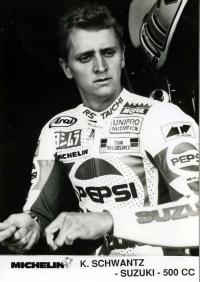Few things polarize the premier-class paddock more than the "black boxes" controlling the spin of rear wheel of a MotoGP prototype motorcycle. Most riders hate it; they'd rather let their talent and throttle hand control the bike. Manufacturers love it; electronics challenge factory engineers and have trickled down to high-performance street bikes.
Who is right? Who is wrong? Both, according to one of the most astute observers of the sport - 1993 500cc World Champion Kevin Schwantz.
"Traction control, there's no doubt that it's made careers last longer; it's made these machines much more forgiving to ride," Schwantz said. "From that perspective, I think it's great. From the competition side, what I want to see is these guys hung off the side of these things with the back tires smoking.
"Whether one or the other is right or correct, or is the right direction for the sport, I'd love to see them without any electronics whatsoever. But I think from a safety perspective, a 250-plus horsepower motorcycle, in a class that we call MotoGP, should have all the latest, greatest technology on it. As far as that goes, everything's going electronic."
34 hits the elusive bull's eye and also succinctly describes the conundrum of traction control.
Anyone can look at YouTube videos of Schwantz sliding the hell out of his Lucky Strike Suzuki 500cc bike or the insane battle between Kenny Roberts and Barry Sheene in 1979 at Silverstone and long for a return to the "good, old days." But would that be MotoGP if the sport returned to 500cc bucking broncos with power delivery, braking and suspension systems more primitive than even the most basic street bike sold today? Hasn't the premier class of Grand Prix motorcycle racing always been about the best of the human and mechanical breed?
Like it or not, the mechanical breed has developed to rely on electronics. Prototype motorcycles are no different than many other consumer products in that regard. People no longer listen to eight-track tapes on players bigger than a FedEx overnight delivery box; they listen to MP3 computer files on electronic devices smaller than a match book. Nobody reads the World Book encyclopedia anymore; they check Google or Wikipedia. Teenagers no longer monopolize the phone every night; they text girlfriends and boyfriends until their thumbs bleed.
Yet music fans, information seekers and teens aren't complaining. It's called evolution of the species.
"Ten years ago, a car didn't have ABS on it," Schwantz said. "Now, 90 percent of what we drive has ABS on it. I think we have to continue to let the manufacturers develop things.
"I'd like to see it, and I don't think there's an in-between. I don't think there's a little bit of electronics. It's either electronics flat out, or none at all, and I don't know how to come up with a happy medium that pleases everybody. But I think traction control, especially spin control, should be in your right hand."
But how? The manufacturers have made it clear they want the latest gizmos on their bikes, and so far Dorna and the FIM have acquiesced. Maybe Dorna will take a more hard-line stance against electronics - on the justification of cost control - in the next two years as Carmelo Ezpeleta continues to forge his vision of a grid filled with a sprinkling of factory bikes and a throng of CRT machines.
A traction control ban could be achieved in MotoGP. In Formula One, the FIA teeter-tottered between allowing and banning traction control in the 1990s and 2000s. Its latest edict was a ban after the 2007 season, with every team using a standard ECU black box.
But the ban on traction control didn't create better racing in F1. The reintroduction of slick tires in 2009 and the debut of the DRS movable rear wing system this season spiced up the show and created much more passing than putting wheel spin back into the control of the driver's right foot.
So the answer to MotoGP's mundane racing during the 800cc era of 2007-11 may not be returning traction control to riders' throttle hands. The elixir for creating better on-track competition may need to be mixed somewhere else. Tires. Testing regulations. Engine size. Teams trying to chase Honda getting their collective, ah, package, together.
Traction control is a convenient whipping boy for all that ails MotoGP. But be careful what you wish for.
source: superbike planet





